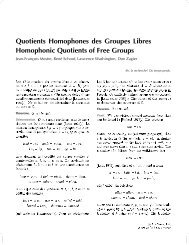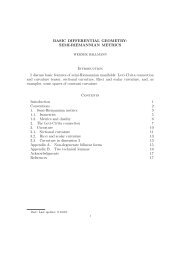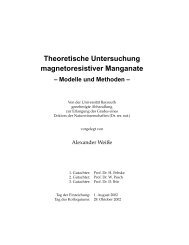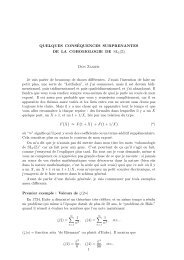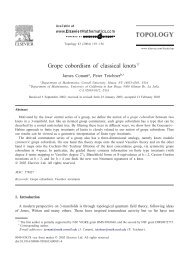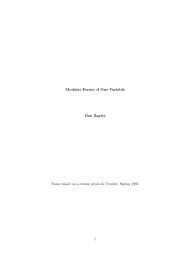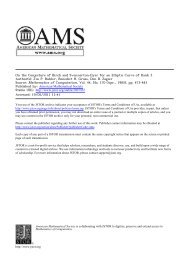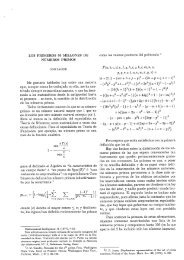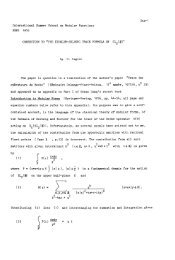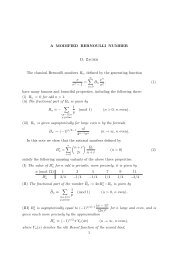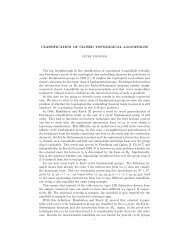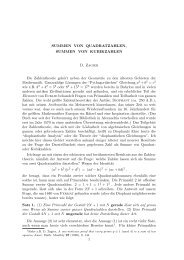38 D. Zagierbecause the transformation law (2) of f implies that the summ<strong>and</strong> associatedto a matrix M = ( abcd)∈Mm is indeed unchanged if M is replaced by γMwith γ ∈ Γ 1 , <strong>and</strong> from (40) one also easily sees that T m f is holomorphicin H <strong>and</strong> satisfies the same transformation law <strong>and</strong> growth properties as f,so T m indeed maps M k (Γ 1 ) to M k (Γ 1 ). Finally, to calculate the effect of T mon Fourier developments, we note that a set of representatives of Γ 1 \M m isgiven by the upper triangular matrices ( )ab0 d with ad = m <strong>and</strong> 0 ≤ b01d k∑b (mod d)( ) az + bf. (41)dIf f(z) has the Fourier development (3), then a further calculation with (41),again left to the reader, shows that the function T m f(z) has the Fourier expansionT m f(z) = ∑ (m/d) ∑ k−1 a n q mn/d2d|mn≥0d>0d|n= ∑ n≥0( ∑r|(m,n)r>0r k−1 a mn/r 2)q n .(42)An easy but important consequence of this formula is that the operators T m(m ∈ N) all commute.Let us consider some examples. The expansion (42) begins σ k−1 (m)a 0 +a m q + ···,soiff is a cusp form (i.e., a 0 =0), then so is T m f.Inparticular,since the space S 12 (Γ 1 ) of cusp forms of weight 12 is 1-dimensional, spannedby Δ(z), it follows that T m Δ is a multiple of Δ for every m ≥ 1. SincetheFourier expansion of Δ begins q + ··· <strong>and</strong> that of T m Δ begins τ(m)q + ···,the eigenvalue is necessarily τ(m), soT m Δ=τ(m)Δ <strong>and</strong> (42) givesτ(m) τ(n) =∑r|(m,n)r 11 τ( mnr 2 )for all m, n ≥ 1 ,proving Ramanujan’s multiplicativity observations mentioned in §2.4. By thesame argument, if f ∈ M k (Γ 1 ) is any simultaneous eigenfunction of all ofthe T m , with eigenvalues λ m ,thena m = λ m a 1 for all m. We therefore havea 1 ≠0if f is not identically 0, <strong>and</strong> if we normalize f by a 1 =1(such anf is called a normalized Hecke eigenform, orHecke form for short) then wehaveT m f = a m f, a m a n = ∑r k−1 a mn/r 2 (m, n ≥ 1) . (43)r|(m,n)Examples of this besides Δ(z) are the unique normalized cusp forms f(z) =Δ(z)E k−12 (z) in the five further weights where dim S k (Γ 1 )=1(viz. k =16,18, 20, 22 <strong>and</strong> 26) <strong>and</strong> the function G k (z) for all k ≥ 4, forwhichwehaveT m G k = σ k−1 (m)G k , σ k−1 (m)σ k−1 (n) = ∑ r|(m,n) rk−1 σ k−1 (mn/r 2 ).(This
<strong>Elliptic</strong> <strong>Modular</strong> <strong>Forms</strong> <strong>and</strong> <strong>Their</strong> <strong>Applications</strong> 39was the reason for the normalization of G k chosen in §2.2.) In fact, a theoremof Hecke asserts that M k (Γ 1 ) has a basis of normalized simultaneous eigenformsfor all k, <strong>and</strong> that this basis is unique. We omit the proof, though itis not difficult (one introduces a scalar product on the space of cusp formsof weight k, shows that the T m are self-adjoint with respect to this scalarproduct, <strong>and</strong> appeals to a general result of linear algebra saying that commutingself-adjoint operators can always be simultaneously diagonalized), <strong>and</strong>content ourselves instead with one further example, also due to Hecke. Considerk =24, the first weight where dim S k (Γ 1 ) is greater than 1. Here S k is2-dimensional, spanned by ΔE4 3 = q + 696q 2 + ··· <strong>and</strong> Δ 2 = q 2 − 48q 3 + ....Computing the first two Fourier expansions of the images under T 2 of thesetwo functions by (42), we find that T 2 (ΔE4) 3 = 696 ΔE4 3 + 20736000 Δ 2<strong>and</strong> T 2 (Δ 2 )=ΔE4 3 + 384 Δ2 .Thematrix ( )696 207360001 384 has distinct eigenvaluesλ 1 = 540 + 12 √ 144169 <strong>and</strong> λ 2 = 540 − 12 √ 144169, so there areprecisely two normalized eigenfunctions of T 2 in S 24 (Γ 1 ), namely the functionsf 1 = ΔE4 3 − (156 − 12√ 144169)Δ 2 = q + λ 1 q 2 + ··· <strong>and</strong> f 2 =ΔE4 3 − (156 + 12√ 144169)Δ 2 = q + λ 2 q 2 + ···,withT 2 f i = λ i f i for i =1, 2.The uniqueness of these eigenfunctions <strong>and</strong> the fact that T m commutes withT 2 for all m ≥ 1 then implies that T m f i is a multiple of f i for all m ≥ 1,soG 24 ,f 1 <strong>and</strong> f 2 give the desired unique basis of M 24 (Γ 1 ) consisting of normalizedHecke eigenforms.Finally, we mention without giving any details that Hecke’s theory generalizesto congruence groups of SL(2, Z) like the group Γ 0 (N) of matrices( abcd)∈ Γ1 with c ≡ 0(modN), the main differences being that the definitionof T m must be modified somewhat if m <strong>and</strong> N are not coprime <strong>and</strong>that the statement about the existence of a unique base of Hecke forms becomesmore complicated: the space M k (Γ 0 (N)) is the direct sum of the spacespanned by all functions f(dz) where f ∈ M k (Γ 0 (N ′ )) for some proper divisorN ′ of N <strong>and</strong> d divides N/N ′ (the so-called “old forms”) <strong>and</strong> a spaceof “new forms” which is again uniquely spanned by normalized eigenforms ofall Hecke operators T m with (m, N) =1. The details can be found in anyst<strong>and</strong>ard textbook.4.2 L-series of EigenformsLet us return to the full modular group. We have seen that M k (Γ 1 ) contains,<strong>and</strong> is in fact spanned by, normalized Hecke eigenforms f = ∑ a m q m satisfying(43). Specializing this equation to the two cases when m <strong>and</strong> n are coprime<strong>and</strong> when m = p ν <strong>and</strong> n = p for some prime p gives the two equations (whichtogether are equivalent to (43))a mn = a m a n if (m, n) =1, a p ν+1 = a p a p ν − p k−1 a p ν−1 (p prime,ν ≥ 1) .The first says that the coefficients a n are multiplicative <strong>and</strong> hence that the∑Dirichlet series L(f,s) = ∞ a n, called the Hecke L-series of f, has an Eu-ns n=1



